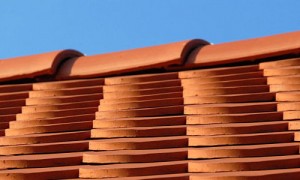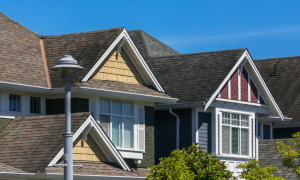When considering energy efficiency, start at the top and think about roofing options that could dramatically increase energy savings for your home. According to the U.S. Dept. of Energy, heating and cooling typically costs more money than any other system in your home. In a hot desert climate such as Las Vegas, cooling generates the highest energy bills by far, so here are a few ideas for roofing that can help keep your home cool.
Think Light for Energy Savings
A “cool” roof, according to the Department of Energy, is designed to maintain lower surface temperature than a traditional roof. In bright sunlight, the cool roof’s surface reflects more sunlight and releases more heat than a hot or dark roof. The U.S. Green Building Council recommends using a light color or white roof, which can substantially reduce heat absorption and keep rooftop temperatures as much as 60 degrees cooler than a conventional dark roof. For low sloping or flat roofs, applying a cool roof coating creates a more energy efficient reflective surface. Cool asphalt shingles can replace standard shingles for greater sunlight reflection.
What’s on the Bottom of your Top?
Many people think of insulation as something that keeps heat in when it’s cold, but energy savings add up just as effectively when you add insulation to block heat on the roof from entering your home. Air seal the attic beneath your roof, check for proper ventilation, then add extra attic insulation. Installing an attic fan also helps to beat the heat.
Make it Mist
While a dry area like Las Vegas may not see much rain, you can still create cooling rooftop moisture by installing a roof mist or evaporative cooling system. These water sprays will cool the roof. For a low-tech solution with a similar effect, simply set a garden hose to mist and position it on the roof.
Materials Make a Difference
Building a new home or re-roofing an existing one is an opportunity to consider cool choices for your roof. Tiles work well for cooling steep slopping roofs, and some traditional tiles even have naturally reflective properties. Unpainted metal roofs naturally have high solar reflectance, making this another option for steep roofs.
Radiant barrier roof sheathing contains a thin layer of aluminum that blocks the transfer of radiant heat from your roof into your home. This product can be installed when constructing a new roof. Solar roof shingles function the same way as solar roof panels: they generate electricity from sunlight. Tax credits are available for up to 30 percent of the cost of qualifying materials. Check out the government’s energy star site for product lists and complete information on tax credits for homeowners who upgrade their existing homes to cool roofs in 2013.
With many products and options available, why settle for just a roof over your head? Your roof can be a big component of an energy efficient home that results in energy savings.
[cf]skyword_tracking_tag[/cf]






